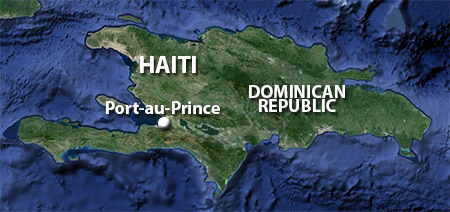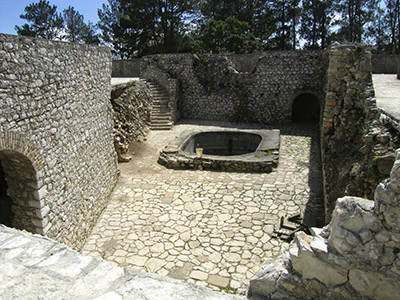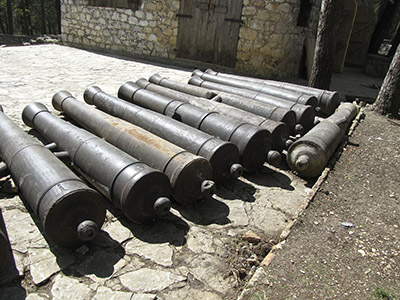 |
Fort Jacques
Port-au-Prince, Haiti
|
|
 |
Constructed: 1804-1806
Used by: Haiti
Conflicts in which it participated:
None
|
Everyone's favorite discoverer and inadvertent-disease-spreader, Christopher Columbus (1451-1506), put the first caucasian toe in the sand of the island that would shortly be named Hispanola on December 5, 1492. |
 |
 |
|
Hispanola enjoyed the Western Hemisphere's first smallpox epidemic in 1507: Thanks, Spain! France soon settled the western third of the island, with Spain controlling the east. Squabbles were many and frequent, until the Treaty of Ryswick officially divided Hispanola between them in 1697.
The French dragged thousands of slaves from Africa to man their sugar cane plantations in the settlement they called Saint-Domingue. By the middle of the 18th century, black folks on Hispanola outnumbered white folks by about ten to one. Inspired by the French Revolution of 1789 (or maybe just discontent about being slaves), insurrection exploded in Saint-Domingue in 1791.
|
 Fort Jacques' all-important cistern. |
 |
Hispanola's black population managed to defeat the efforts of France, Spain and Great Britain (who spent 1794-1798 occupying some of the west of the island, taking advantage of France's discomfiture), ejecting just about all of the wicked white folks from the island by 1800 (those few that remained were massacred in 1804). France was so chastened by the experience that it abolished slavery in all of its colonies.
But it wasn't chastened enough to give up on reestablishing control of Hispanola! In 1802, Napoleon (1769-1821) sent over 20,000 troops to retake the island. Within a year, France had lost 50,000 troops on Hispanola, mostly to Yellow Fever.
|
|
|
With Haiti finally scrubbed clean of French people (and wishing to remain thus cleansed), Jean-Jacques Dessalines (1758-1806), a slave turned revolutionary turned Governor-General turned Emperor Jacques I, immediately began building two starforts in the hills around Port-au-Prince, his capital city: Fort Alexandre and Fort Jacques.
|
Named of course for Emperor Jacques, work on Fort Jacques began in 1804. It's an irregularly-shaped star, necessary to conform to the terrain on which it sits. The fort's oddest feature is the huge, bulbous rotunda that replaces what ought to be a properly pointy northwest bastion.
Apparently I'm not the only one to be offended by this starfort affrontery: In the tragic earthquake of 2010, that one circular bastion crumbled, while the other three survived relatively unscathed. See? God agrees with me. And/or, the pointed bastion is a much stronger structure. Which we know, because we love starforts, and starforts do not consist of round things.
The fort was armed with French and British guns, as both empires had left plenty behind in their hurry to stop dying of Yellow Fever.
|
 |
Fort Jacques' improper northwest bastion was eventually addressed with divine intervention. |
|
Fort Alexandre was simultaneously built just about half a "kilometer" to the southeast of Fort Jacques. Choosing to build two forts in such close proximity seems strange, but it speaks to the range and notional effectiveness of that era's artillery. Both forts have a commanding view of Port-au-Prince, and would be capable of firing over the city at enemies approaching from the sea. A tunnel connected Forts Alexandre and Jacques.
|
 A collection guns thoughtfully provided by France and Great Britain. |
 |
Another key figure in Haiti's independence was Alexandre Pétion (1770-1818), after whom Fort Alexandre was named. Pétion may hold the distinction of being the only guy in history who caused his very own starfort to be abandoned immediately after it was completed.
Dissatisfied with "emperor for life" Jacques I, Pétion and others conspired for his overthrow. Dessalines was assassinated on October 17, 1806: That very day, Fort Jacques and Fort Alexandre were abandoned.
In the ensuing silliness that gripped Haiti through the rest of the 19th century, Fort Jacques was lightly manned, but never called into action. |
|
|
Today, Fort Jacques is being developed as a tourist attraction. Convict labor is reportedly being used to drag those two-ton cannon around (hopefully they are carefully accounted for each day, lest one be smuggled back into prison). A restaurant, bathrooms and parking facilities have been built, and some repairs of the earthquake damage has been undertaken.
|
|
|
Earthquake damage to Fort Jacques' southwest bastion. Clean that mess up, convicts!
|
|
|
|
|
|
 |




